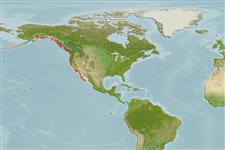>
Perciformes/Zoarcoidei (Eelpouts and pricklebacks) >
Opisthocentridae ("Rearspined fin pricklebacks")
Etymology: Lumpenopsis: Latin, lumpus, an uncouthlooking spiny-finned fish of a leaden-blue colour + Greek, opsis = appearance (Ref. 45335).
More on authors: Hubbs & Schultz.
Environment: milieu / climate zone / depth range / distribution range
Οικολογία
Θαλασσινό(ά) βενθοπελαγικό; εύρος βάθους 30 - 100 m (Ref. 51666). Temperate
Eastern Pacific: southern British Columbia, Canada to California, USA.
Μέγεθος / Βάρος / Age
Maturity: Lm ? range ? - ? cm
Max length : 7.6 cm TL αρσενικό/απροσδιόριστο; (Ref. 2850)
Short description
Κλείδες προσδιορισμού | Μορφολογία | Μορφομετρία
Ραχιαίες άκανθες (συνολικά) : 44; Εδρικές άκανθες: 1; Μαλακές εδρικές ακτίνες: 31. Caudal oval; pectorals large, pointed (Ref. 6885).
Found in sandy to rocky bottoms (Ref. 51666).
Life cycle and mating behavior
Maturities | Αναπαραγωγή | Spawnings | Egg(s) | Fecundities | Προνύμφες
Eschmeyer, W.N., E.S. Herald and H. Hammann, 1983. A field guide to Pacific coast fishes of North America. Boston (MA, USA): Houghton Mifflin Company. xii+336 p. (Ref. 2850)
IUCN Red List Status (Ref. 130435)
Threat to humans
Harmless
Human uses
Εργαλεία
Special reports
Download XML
Διαδικτυακές πηγές
Estimates based on models
Preferred temperature (Ref.
123201): 8 - 11.8, mean 8.7 °C (based on 11 cells).
Phylogenetic diversity index (Ref.
82804): PD
50 = 0.5625 [Uniqueness, from 0.5 = low to 2.0 = high].
Bayesian length-weight: a=0.00102 (0.00046 - 0.00225), b=3.06 (2.88 - 3.24), in cm total length, based on all LWR estimates for this body shape (Ref.
93245).
Τροφικό Επίπεδο (Ref.
69278): 3.0 ±0.00 se; based on food items.
Fishing Vulnerability (Ref.
59153): Low vulnerability (10 of 100).
